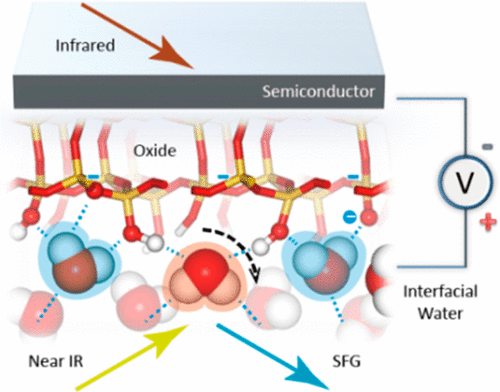当前位置:
X-MOL 学术
›
J. Phys. Chem. Lett.
›
论文详情
Our official English website, www.x-mol.net, welcomes your
feedback! (Note: you will need to create a separate account there.)
Gate-Controlled Sum-Frequency Vibrational Spectroscopy for Probing Charged Oxide/Water Interfaces
The Journal of Physical Chemistry Letters ( IF 4.8 ) Pub Date : 2019-09-20 , DOI: 10.1021/acs.jpclett.9b01908 Hongqing Wang 1, 2 , Qian Xu 1, 2 , Zhihua Liu 1, 2 , Yiming Tang 1, 2 , Guanghong Wei 1, 2 , Y. Ron Shen 1, 3 , Wei-Tao Liu 1, 2
The Journal of Physical Chemistry Letters ( IF 4.8 ) Pub Date : 2019-09-20 , DOI: 10.1021/acs.jpclett.9b01908 Hongqing Wang 1, 2 , Qian Xu 1, 2 , Zhihua Liu 1, 2 , Yiming Tang 1, 2 , Guanghong Wei 1, 2 , Y. Ron Shen 1, 3 , Wei-Tao Liu 1, 2
Affiliation

|
The rich chemistry of oxide/aqueous interfaces originates from the interfacial layer formed by surface charges and adjoining water molecules. Yet not much is clear about such layers, because they are difficult to access, and measurements unavoidably collect signals from the diffuse layer nearby, which is perturbed by the surface potential extending into the bulk water. Here we show that gating of a semiconductor/oxide/water junction can effectively vary the surface charge density at the oxide/water interface but keep the surface potential low and barely varying, allowing effective removal of the diffuse layer contribution. With sum-frequency vibrational spectroscopy on a silicon/silica/deionized-water model junction, the variation of the bonded layer water structure in response to surface charging can be readily detected. This new scheme is generally applicable to all oxide/water interfaces, providing opportunities for future investigations at a deeper molecular level.
中文翻译:

门控和频振动光谱法,用于探测带电氧化物/水界面
氧化物/水界面的丰富化学物质源自表面电荷和邻接的水分子形成的界面层。但是,由于难以接近这些层,因此并不清楚,因为测量不可避免地会从附近的扩散层收集信号,该信号会受到扩展到大量水中的表面电势的干扰。在这里,我们表明,半导体/氧化物/水结的门控可以有效地改变氧化物/水界面处的表面电荷密度,但保持较低的表面电势且几乎不变化,从而可以有效地消除扩散层的影响。利用硅/二氧化硅/去离子水模型结上的和频振动光谱法,可以很容易地检测到键合层水结构响应表面电荷而发生的变化。
更新日期:2019-09-21
中文翻译:

门控和频振动光谱法,用于探测带电氧化物/水界面
氧化物/水界面的丰富化学物质源自表面电荷和邻接的水分子形成的界面层。但是,由于难以接近这些层,因此并不清楚,因为测量不可避免地会从附近的扩散层收集信号,该信号会受到扩展到大量水中的表面电势的干扰。在这里,我们表明,半导体/氧化物/水结的门控可以有效地改变氧化物/水界面处的表面电荷密度,但保持较低的表面电势且几乎不变化,从而可以有效地消除扩散层的影响。利用硅/二氧化硅/去离子水模型结上的和频振动光谱法,可以很容易地检测到键合层水结构响应表面电荷而发生的变化。


















































 京公网安备 11010802027423号
京公网安备 11010802027423号